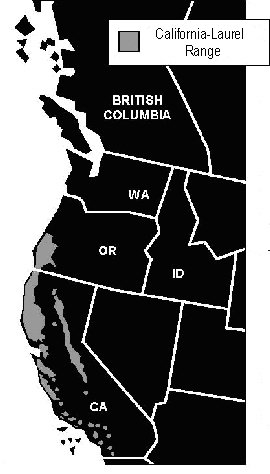The California Laurel Tree is estimated to be over 200 years old and was alive
when Miller Creek School grounds were known as the Miwok Village "Cotomko'tca" in the early 1800s
Dixie School District Supervisor, Jason Yamashiro, did not inform the public before ripping this tree down in violation of Marin County's Heritage Tree ordinance. A few changes to the existing plan could have easily save this treasure.
The drawings for the renovation at Miller Creek School have never been published. A public hearing was warranted but instead the District decided to keep the plans hidden from public view.
Tom Lai, attorney for Marin County Community Development Department was contacted but said they have no jurisdiction over the Dixie School District. Apparently, the Dixie School district cannot be bothered to abide by sensible building guidelines..
Jason Yamashiro resigned in 2019 amid the Dixie School District renaming controversy. His last day is Friday, June 28, 2019.
California-laurel (Umbellularia californica)
 Pacific-myrtle, Oregon-myrtle, California bay, pepperwood, spice-tree
Pacific-myrtle, Oregon-myrtle, California bay, pepperwood, spice-tree- General Characteristics
- Biology & Management
- Harvest & Utilization
- Wood Properties
- Related Literature
- Oregon Producers and Users of California-laurel (myrtlewood)
This information was originally published in Hardwoods of the Pacific Northwest, S.S. Niemiec, G.R. Ahrens, S. Willits, and D.E. Hibbs. 1995. Research Contribution 8. Oregon State University, Forest Research Laboratory
General Characteristics
 California-laurel is the only tree of the family Lauraceae found in the western United States. It is a broadleaved evergreen tree with distinctly aromatic “bay” leaves. Often referred to as myrtlewood, California-laurel is one of the best known and most valuable western hardwoods.
California-laurel is the only tree of the family Lauraceae found in the western United States. It is a broadleaved evergreen tree with distinctly aromatic “bay” leaves. Often referred to as myrtlewood, California-laurel is one of the best known and most valuable western hardwoods.
Size, Longevity, and Form
Typical California-laurels are 40 to 80 ft tall and 18 to 30 in. in diameter. On good bottomland sites, mature trees can attain diameters of 36 to 72 in. (159 in. maximum) and heights of over 100 ft (175 ft maximum). California-laurels may live at least 200 years. The trees often have forked or multiple stems with ascending branches, which form dense, round-topped crowns. In forest stands, the stems or limbs are relatively straight, vertical, and clear of smaller branches. Open-grown trees have broad spreading crowns (often wider than tree height) supported by several main stems or branches. The root system of California-laurel is wide and spreading, although it varies from shallow to deep, depending on the soil and drainage.
Typical California-laurels are 40 to 80 ft tall and 18 to 30 in. in diameter. On good bottomland sites, mature trees can attain diameters of 36 to 72 in. (159 in. maximum) and heights of over 100 ft (175 ft maximum). California-laurels may live at least 200 years. The trees often have forked or multiple stems with ascending branches, which form dense, round-topped crowns. In forest stands, the stems or limbs are relatively straight, vertical, and clear of smaller branches. Open-grown trees have broad spreading crowns (often wider than tree height) supported by several main stems or branches. The root system of California-laurel is wide and spreading, although it varies from shallow to deep, depending on the soil and drainage.
Geographic Range
The range of California-laurel extends from Reedsport, Oregon (lat 44 °N) to San Diego, California (lat 33 °N). It is not found more than 160 miles from the Pacific Coast. California-laurel is found in the Coast Ranges, the southwestern Cascade Range, and all along the western Sierra Nevada.
The range of California-laurel extends from Reedsport, Oregon (lat 44 °N) to San Diego, California (lat 33 °N). It is not found more than 160 miles from the Pacific Coast. California-laurel is found in the Coast Ranges, the southwestern Cascade Range, and all along the western Sierra Nevada.
Timber Inventory
The total inventory of California-laurel is about 520 MMCF of growing stock, of which 93 MMCF occurs in southwestern Oregon (Appendix 1, Table 1, excluding federal lands in southwestern Oregon, for which there are no recent estimates). Many of the best trees are found in parks and riparian areas. According to some representatives of the myrtlewood industry, available supplies of the high-value, figured wood are getting scarce.
The total inventory of California-laurel is about 520 MMCF of growing stock, of which 93 MMCF occurs in southwestern Oregon (Appendix 1, Table 1, excluding federal lands in southwestern Oregon, for which there are no recent estimates). Many of the best trees are found in parks and riparian areas. According to some representatives of the myrtlewood industry, available supplies of the high-value, figured wood are getting scarce.
No comments:
Post a Comment